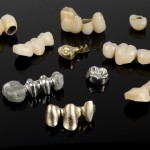
Porcelain-fused-to-metal (PFM) crowns have been used for the many years as the first choice for restoring damaged or diseased posterior teeth as they have good mechanical and aesthetic properties. However, their metal framework does limit their aesthetic properties and in recent decades all-ceramic crowns have been used to overcome these limitations. The objective of this review was to evaluate the clinical and cost-effectiveness of dental PFM and all-ceramic crowns.
Methods
Searches were conducted in PubMed, The Cochrane Library, University of York Centre for Reviews and Dissemination (CRD), ECRI databases, Canadian and major international health technology agencies. Studies of that addressed the clinical or cost effectiveness of porcelain-fused-to-metal crowns and all ceramic dental crowns were identified with health technology assessments, systematic reviews, meta-analyses, randomized controlled trials, non-randomized studies and economic studies published in English being considered. Systematic reviews were assessed using the AMSTAR tool with the Downs and Black checklist being used for randomised and non-randomised studies and the Drummond checklist for economic studies.
A narrative summary and critical appraisal of the included studies is presented.
Results
- 29 studies were included
- 22 studies (10 systematic reviews, 1 RCTs and 11 non-randomised studies) addressed longevity of all-ceramic crowns
- 2 studies considered the longevity of metal-ceramic crowns
- 4 studies compared the longevity of all-ceramic and metal-ceramic crowns.
- 1 study undertook a cost evaluation.
Conclusions
The authors concluded:
With respect to the long-term survival (> 8 years) of all-ceramic crowns, data showed that survival rate varied from one study to another and from one type of ceramic to another; variation ranged from 83.9% and 100%. The long-term survival of porcelain fused to metal crowns ranged from 92.3% to 95.9%. Comparative data showed lower survival rate for all-ceramic crowns (48%) relative to porcelain fused to metal crowns (62%).
The cost-effectiveness analysis showed that all-ceramic (porcelain jacket) crowns were more cost-effective than PFM crowns until 10 years of the restoration life; after this time, PFM crowns become more cost-effective. However, these findings might not be generalizable to the currently used all-ceramic crowns because the study was based on restorations fabricated before 1985.
Comments
This review from the Canadian Agency for Drugs and Technologies in Health (CADTH) is not intended to be a thorough systematic review of the evidence comparing porcelain fused to metal crowns with all-ceramic crowns. Consequently the review focuses on previously published systematic reviews some of which we have blogged about previously (see links). Overall the document provides a helpful summary of the available evidence and can be downloaded free from PubMed Health.
Links
Porcelain-Fused-to-Metal Crowns versus All-ceramic Crowns: A Review of the Clinical and Cost-Effectiveness [Internet]. Ottawa (ON): Canadian Agency for Drugs and Technologies in Health; 2015 May 29. Available from http://www.ncbi.nlm.nih.gov/books/NBK304693/ PubMed PMID: 26180882.

Porcelain-fused-to-metal(PFM) or all-ceramic crowns?
http://t.co/dCGYYvI196
Long-term survival of PFM crowns ranges 92.3% – 95.9% http://t.co/dCGYYvI196
Long-term survival of all ceramic crowns ranges 83.9%-100%.http://t.co/dCGYYvI196
Lower survival rate for all-ceramic (48%) relative to PFM crowns (62%). http://t.co/dCGYYvI196
Don’t miss – Porcelain-fused-to-metal(PFM) or all-ceramic crowns?
http://t.co/dCGYYvI196
[…] Porcelain-fused-to-metal crowns or all-ceramic crowns? […]